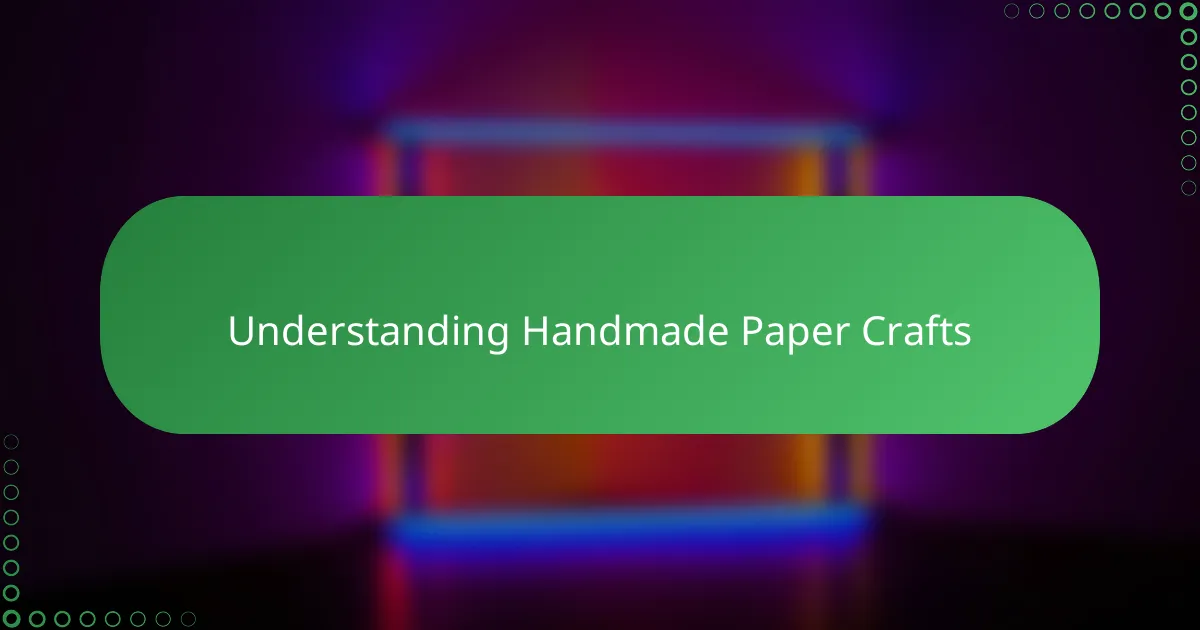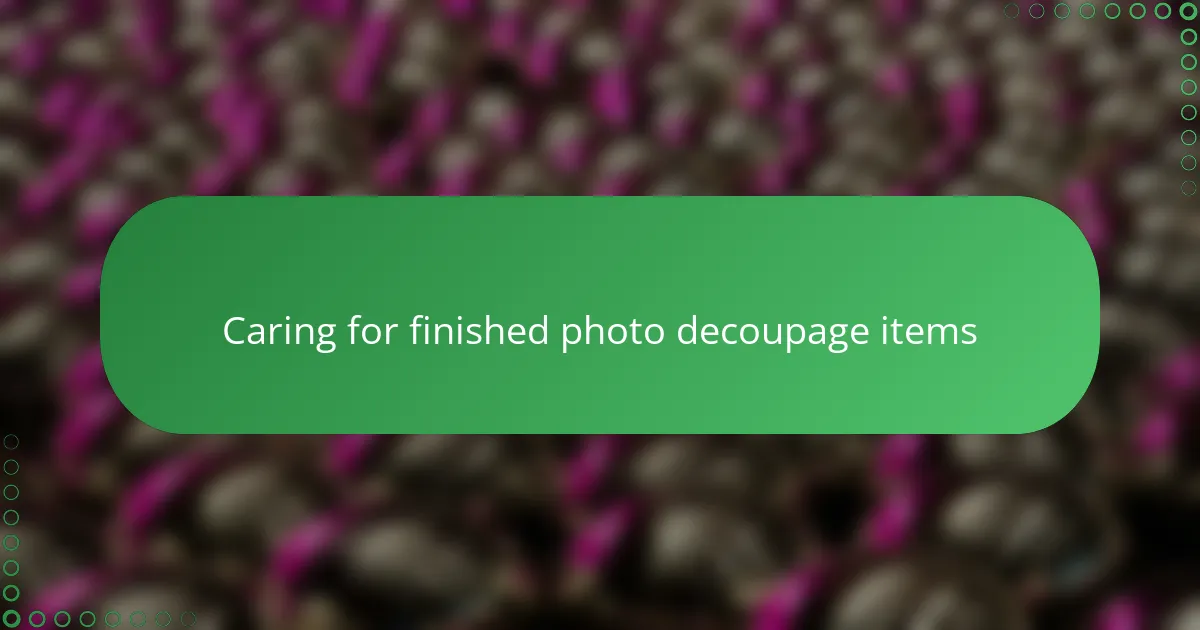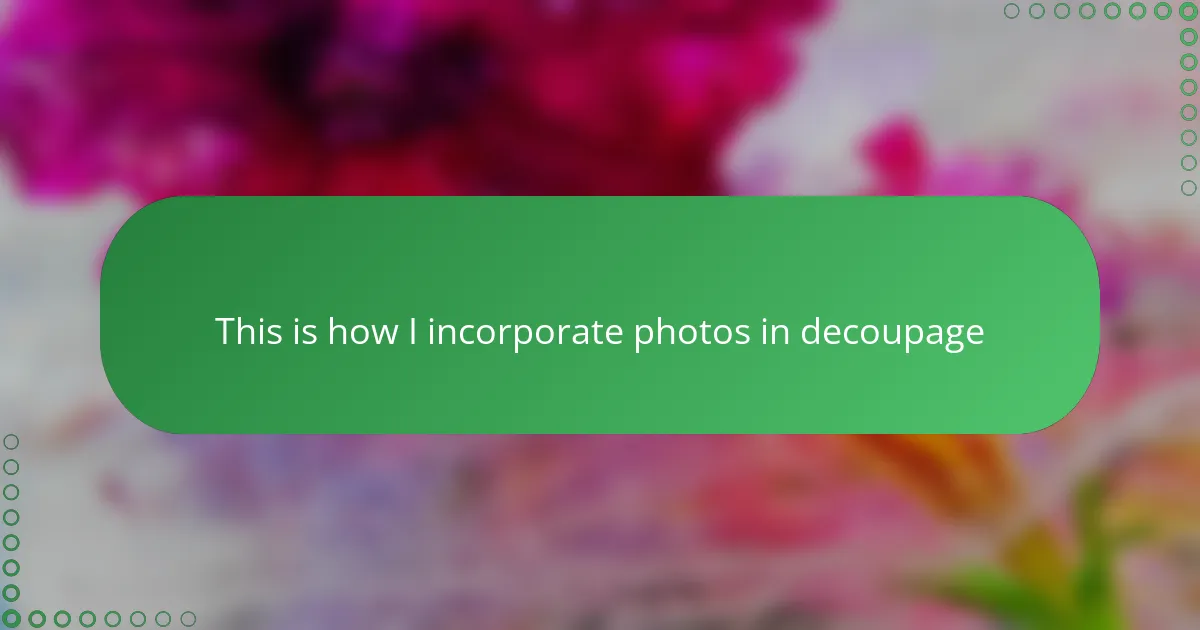Key takeaways
- Handmade paper crafts offer a unique texture and organic feel, inspiring creativity through their personal touch.
- Decoupage transforms ordinary items into artistic expressions using patience and attention to detail while selecting photos that evoke emotion enhances the storytelling aspect.
- Preparation, including choosing finishes and carefully trimming photos, is crucial for achieving a polished and dynamic decoupage piece.
- Caring for finished items involves protecting them from sunlight, dust, and extreme conditions to maintain their beauty and longevity.

Understanding handmade paper crafts
Handmade paper crafts have a unique charm that machine-made papers often lack. From my own experience, there’s something calming about the texture and organic feel that handmade paper brings—it’s like holding a piece of art even before it’s been shaped. Have you ever noticed how each sheet tells its own story through tiny fibers and irregular edges?
What fascinates me most is the entire process behind handmade paper, which involves patience and care that naturally translate to the final craft. It’s almost meditative—immersing pulp in water, spreading it carefully, and watching it dry slowly under the sun. This hands-on involvement makes every craft feel deeply personal.
Isn’t it interesting how such simplicity can produce so much variety? The tactile quality of handmade paper invites creativity in a way that feels authentic and heartfelt. In my projects, using handmade paper often inspires new ideas, pushing me to experiment with textures and layering techniques I might have never tried otherwise.

Introduction to decoupage techniques
Decoupage, at its core, is all about transforming ordinary surfaces with layers of paper and glue, creating a collage that feels alive and textured. When I first tried decoupage, I was struck by how simple materials—mostly cutouts and adhesive—could turn something plain into a personal statement. Have you ever found yourself mesmerized by the way overlapping images blend into a new story?
What makes decoupage so captivating for me is its versatility; you can work on anything from furniture to small keepsakes, and each project becomes a unique expression. The technique itself requires patience and a gentle touch, especially when smoothing out layers to avoid bubbles or wrinkles—a step that really tests your attention to detail and care.
I’ve noticed that mastering the basic steps—cutting precise shapes, applying glue just right, and sealing the final creation—opens up endless possibilities for creativity. It’s a bit like painting with paper, where your imagination guides the design and every piece contributes to the bigger picture. Doesn’t that make you want to start your own project right away?

Choosing photos for decoupage
Choosing photos for decoupage is more than just picking pretty pictures; it’s about selecting images that resonate with the story you want to tell. I often look for photos that evoke a feeling—whether it’s nostalgia, joy, or whimsy—because those emotions shine through in the final piece. Have you ever found yourself lingering on a photo because it sparks a memory or a smile?
One thing I’ve learned is to consider the size and detail of the photo carefully. Smaller images or ones with bold, clear features tend to stand out better after layering and sealing. I remember a project where I used a finely detailed family portrait, and the tiny faces ended up a bit muddy—I realized that sometimes simplicity wins over complexity.
Color balance is another key factor I pay attention to. Photos with a harmonious palette blend seamlessly with the handmade paper’s natural hues. Sometimes I even edit photos slightly to mute or enhance colors so they complement the textures beneath. Doesn’t it feel satisfying when all elements just click together effortlessly?

Preparing photos for decoupage projects
Preparing photos for decoupage projects means thinking beyond just printing them out. I usually start by deciding whether I want a matte or glossy finish because the surface texture can totally change how the photo interacts with the glue and paper beneath. Have you tried experimenting with different finishes and noticed how it affects the overall depth of your piece?
I also find it essential to trim photos carefully, sometimes cutting around key shapes to create interesting edges rather than sticking to straight lines. One time, I cut out individual flowers from a photo, and it gave my decoupage a playful, layered look that felt much more dynamic than a plain rectangle. Don’t you love how a small detail like that can elevate the whole design?
Another trick I swear by is lightly sanding thicker photo paper before applying glue. It might sound odd, but this helps the adhesive soak in better and prevents bubbling or peeling over time. Have you ever had a photo lift off your project? This little step has saved me from that frustration more than once.

Step-by-step photo decoupage process
Starting the decoupage process, I usually begin by carefully arranging my photos on the surface without glue at first. This step lets me experiment with layouts—sometimes I think a simple overlap adds a surprising depth, other times I rearrange several times until it just feels right. Have you ever found yourself shifting images around for what seems like ages, just to capture that perfect balance?
Applying the adhesive requires a gentle hand and patience; I prefer using a soft brush to spread glue evenly beneath each photo. From experience, too much glue can cause wrinkles or bubbles, which is so frustrating because it takes away from the smooth finish I’m aiming for. Do you find that pressing lightly with a clean cloth helps to smooth out any air pockets without damaging the delicate paper?
Once everything is glued down and dry, sealing the project is the final magic touch. I like using a water-based sealer applied in thin coats, allowing each to dry fully—it preserves the photos’ vibrancy while adding a protective layer. Have you noticed how sealing not only protects but also gives the piece a lovely gentle sheen that brings the whole decoupage to life?

Tips for incorporating photos creatively
One tip I’ve found invaluable is to play with layering photos in unexpected ways—like overlapping edges or cutting out interesting shapes from the photo itself. Once, I tried cutting around the silhouette of a flower in a picture, and that little tweak added so much dimension to my piece. Have you ever experimented with shapes beyond the traditional rectangle? It can really transform your decoupage into something unique.
Another thing I always consider is mixing photo textures and finishes. Combining matte and glossy photos adds a subtle contrast that catches the eye and makes the collage more dynamic. From my experience, even subtle differences in sheen can highlight focal points without overwhelming the overall design. Don’t you think that tiny details like this make your craft feel that much more special?
Lastly, I like to integrate background elements—like faint handwritten notes or vintage patterns behind the photos—to give the piece depth and a story-like quality. One project I worked on had a background of soft script writing, and layering photos on top made the whole work feel nostalgic and heartfelt. Have you tried blending photos with graphic or textual layers to enrich your decoupage’s narrative? It’s a creative touch worth exploring.

Caring for finished photo decoupage items
Caring for finished photo decoupage items means treating them like delicate treasures. From my experience, keeping these pieces away from direct sunlight helps prevent colors from fading—a subtle but crucial step that preserves the vibrancy I worked so hard to achieve. Have you ever noticed how a sunbleached photo suddenly loses its charm?
I also find that dusting gently with a soft, dry cloth does wonders. Avoiding harsh cleaners or excessive moisture is key because water can lift or wrinkle the paper layers, which is frustrating after all that careful gluing. Isn’t it amazing how something so fragile can hold such emotional weight?
Lastly, storing decoupage items in a stable environment—away from extreme heat or humidity—has saved me from unexpected damage more than once. I remember a project that warped slightly after being placed near a heater; since then, I’m extra mindful about where I display these cherished crafts. Don’t you think that a little extra care makes every handmade creation last longer?
